Wood Ants: Illustrating a guide to the wood ants of the Cairngorms
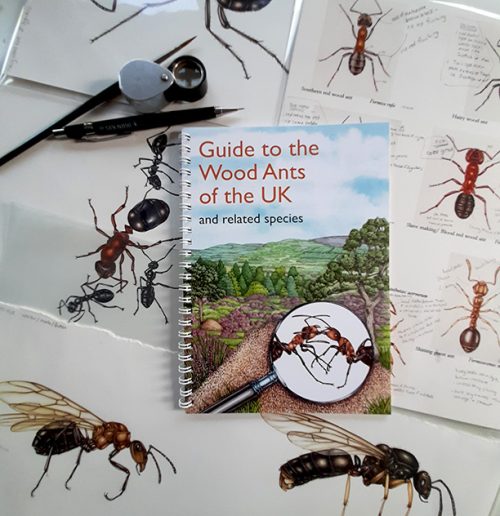
Earlier this year, I had one of the hardest and most wonderful jobs. I was commissioned to illustrate all the Wood ants species that occur in the UK for an identification guide which has just been published by the Cairngorms National Park Authority . The physical guide is now available (and a classy item t is too, really good production values!) To download a free PDF of the guide, please visit: https://lnkd.in/d_qUdgU. Although this only totals 6 species, it was a properly challenging task, and took me to the limits of my abilities. And that is something I relish. Almost all of the original illustrations are available to buy, check them out here or email me on info@lizzieharper.co,uk for more information.
The Commission
The Cairngorms National Park approached me, wanting illustrations for a guide to Wood ants. I’ve only painted a couple of ants before, and never in any enormous detail. Truth be told, I’ve not even painted that many hymenoptera…up til now! This would involve detailed and accurate illustrations of six ant species. It also needed illustrations of the life cycle of the wood ant. Close-ups of species specific details were also needed. these would help people tell the species apart by checking out their heads, hairiness, or “lip”.
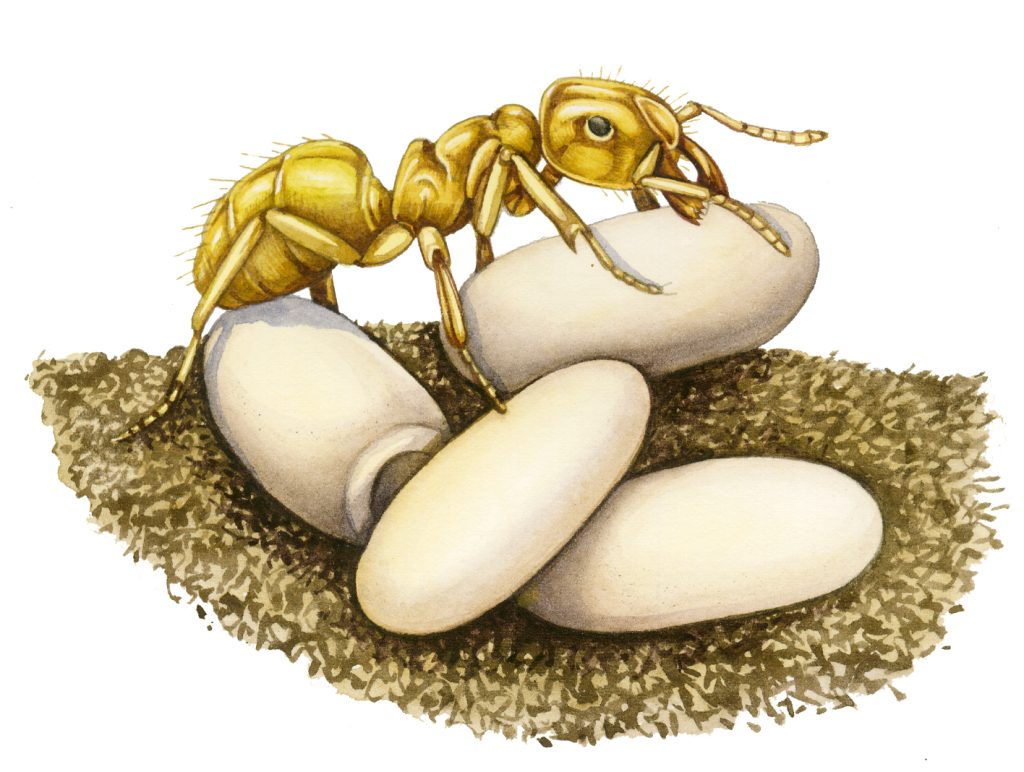
Yellow meadow ant Lasius flavus. NOT a wood ant, but the only other ant I’d painted before this job.
The deadline was flexible (thank goodness) and Hayley, the Conservation officer who oversaw the project, was brilliant to work with.
We decided exactly what images were needed, and then she gathered reference for me
How to get reference to illustrate ants?
Getting reference was tricky. It was winter, so the ants were all inactive and their nests were, in many cases, not obvious. However, Hayley got me photos of the ant hills. These vary from species to species, and can be indicators to help tell the ants apart.
She also pointed me to an amazing resource for all things ant, Ant web. Ant web has very detailed photos for every species on ant you can imagine. Photos are taken from above, face on, and from the side. You can imagine how helpful this resource was. However, you can’t just steal other people’s imagery. We needed more reference to ensure I didn’t infringe anybody’s copyright.
Amazingly, Hayley got me specimens of every species that I needed to draw. Not only that, but she got me pinned specimens and loose specimens, in tiny test tubes. She even got me queens of several species. This was amazing, I had my actual subjects to work from. the only problem was the largest was a maximum of 9mm long. And the smallest is about 3mm.
I’m lucky enough to count Mixie, or Antonia Fraser as a friend. She’s an excellent wildlife photographer who lives nearby. I hired her to take close up photos of my gorgeous ants. It was clearly technically extremely challenging, but she took all the photos I needed. All were useful, many were beautiful.
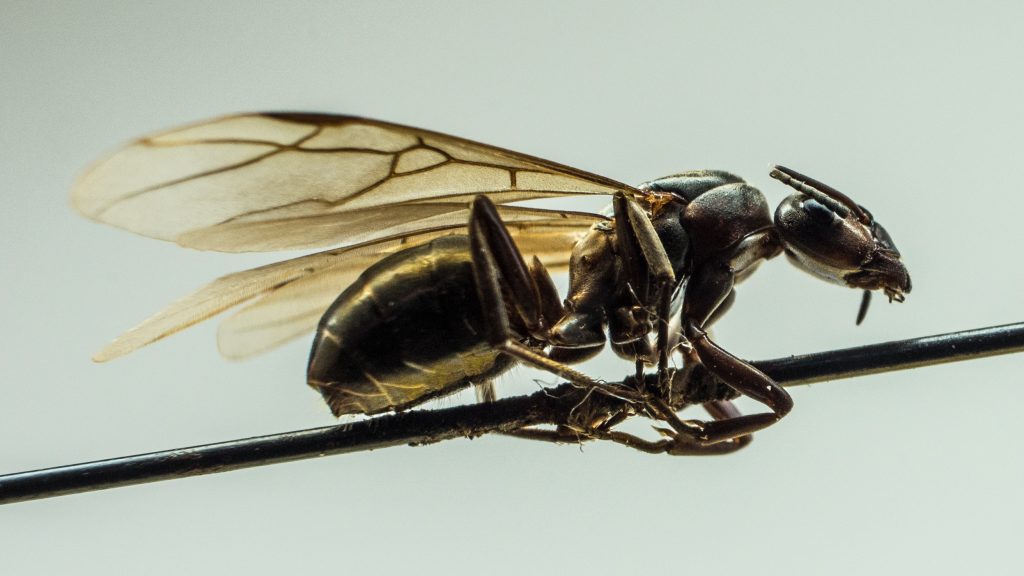
Mixie’s photo of the Queen Scottish Wood ant Formica aquilonia
Illustrating wood ants
Armed with my ants, written descriptions, very helpful notes from Hayley, and my photos; I began. As always, you start by doing a rough. this is an accurate pencil drawing, which the client can check for accuracy before you move onto adding colour.
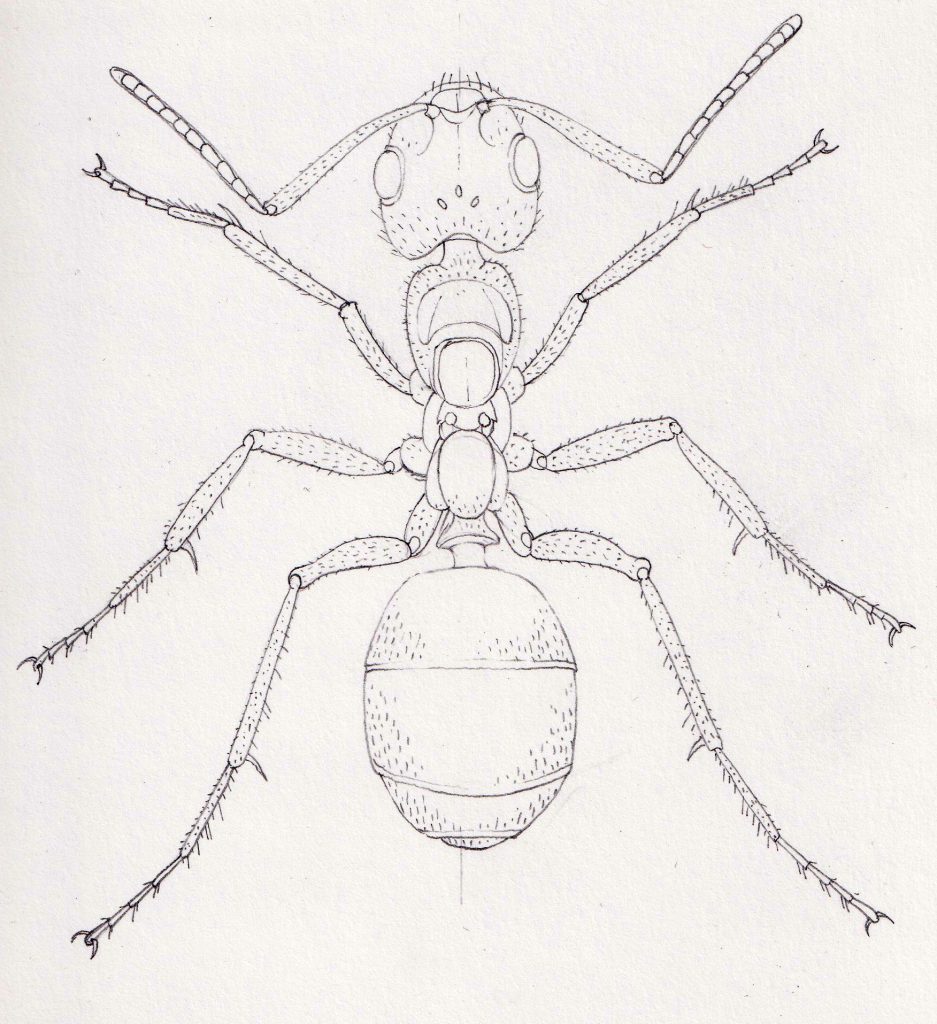
Narrow headed ant Formica exsecta pencil rough
In this case, as colour is so critical, I also did some colour tests. These were print outs of the pencil roughs, which I then coloured and sent off to Hayley. The colour can change in pinned and dead specimens, so I knew this was an important step.
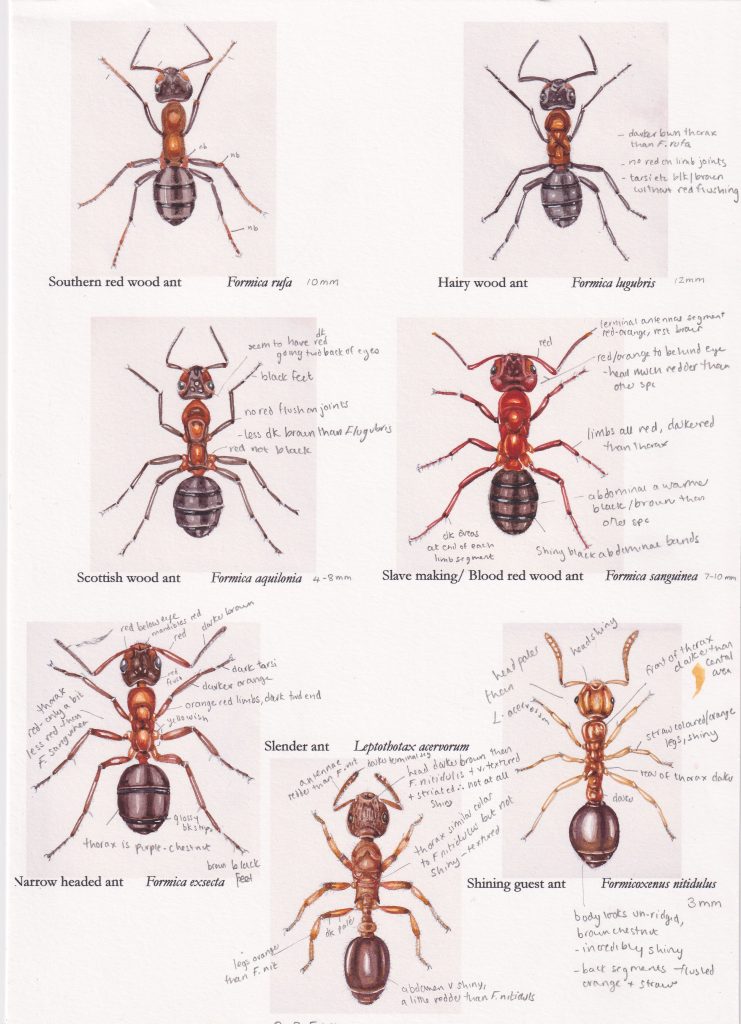
Colour roughs of the ant species, with my written notes
Feedback was excellent and extensive. Several experts were on board, so there were plenty of alterations needed. I never mind this at all. It’s incredibly easy to make changes to a pencil rough, but can be almost impossible to tweak a completed watercolour.
Once all the roughs were approved, I could move onto the final illustrations.
Illustrating wood ants
I will not lie. As I put paint to the first of the ants I was very anxious. Keeping the colours and details accurate was vital. I worked closely with Mixie’s photos, the feedback, the tiny ants under my dissecting microscope. But somehow once I’d begun it wasn’t that bad. I had to concentrate and had to remember the anatomy of the ants. Their comparative shiny-ness was a consideration. The trickiest part was the head. Untangling shadows from lips and mandibles was tough. But we got there.

Southern Red wood ant Formica rufa with colour tests, paintbox and brush
Once I’d done one, the rest were easier. I’d start with the head, the most challenging part. Then the thorax. Next the abdomen. Finally, the easy bit: the legs.
I warmed to my work, learning to love these incredible creatures more and more as I painted their portraits.
One of the illustrations needed was a generic “ant”, in side view. I chose to base this on the Scottish wood ant, Formica aquilonia. She’s turned out to be one of my favourite illustrations from the commission.
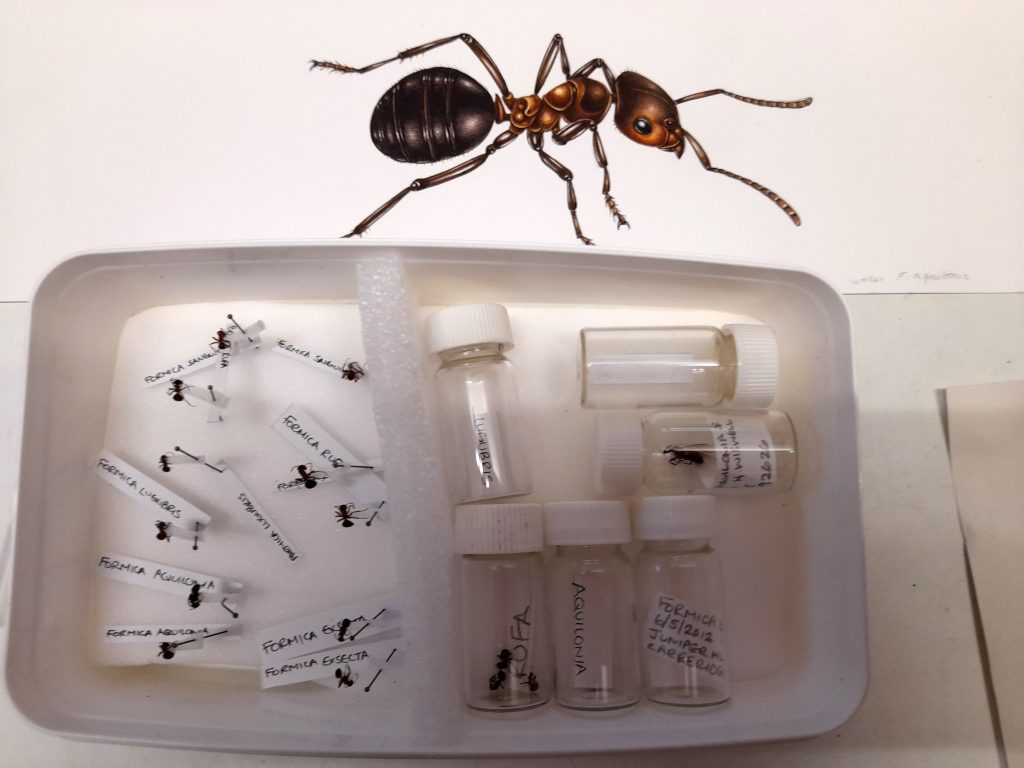
Generic ant, with my lovely UK Wood ant reference collection below.
I painted onto Fluid 100 hotpress watercolour paper. Winsor and Newton watercolour paints make up most of my paint box. My paintbrush was a Winsor and Newton series 7 brush, sizes 1 and a tiny 000 for the hairs. And don’t forget, the presence or absence of hairs is extremely important!
My favourite ant
I know you’re not meant to have favourites, but I do. The Shining guest ant Formicoxenus nitidulus is a tiny insect. She’s only 2 or 3 mm long, but oh, does she pack a punch! These ants look like they’ve been dipped in resin. They are startlingly shiny. They look like jewels, or highly polished wood. With the two contrasting colours of her abdomen and thorax, I was utterly smitten,
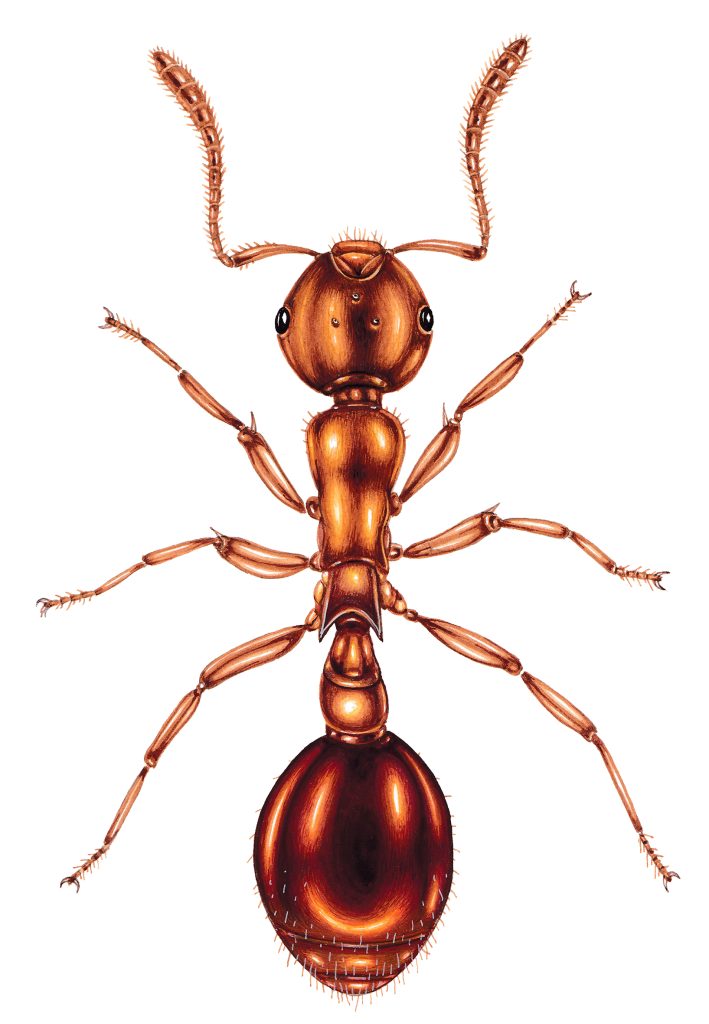
Shining Guest ant Formicoxenus nitidulus
She was also hard to illustrate. Getting the shine to be as violent and bright as it is in nature proved almost impossible. But I was pleased with the finished illustration.
Another favourite was the Blood or Slave-making wood ant Formica sanguinea. Not only does this species look pretty cool, being quite a bright red, but they also have a wonderfully sinister side. They enslave other ant species, kill the resident queen, and have their young reared in these cuckoo-style nests.
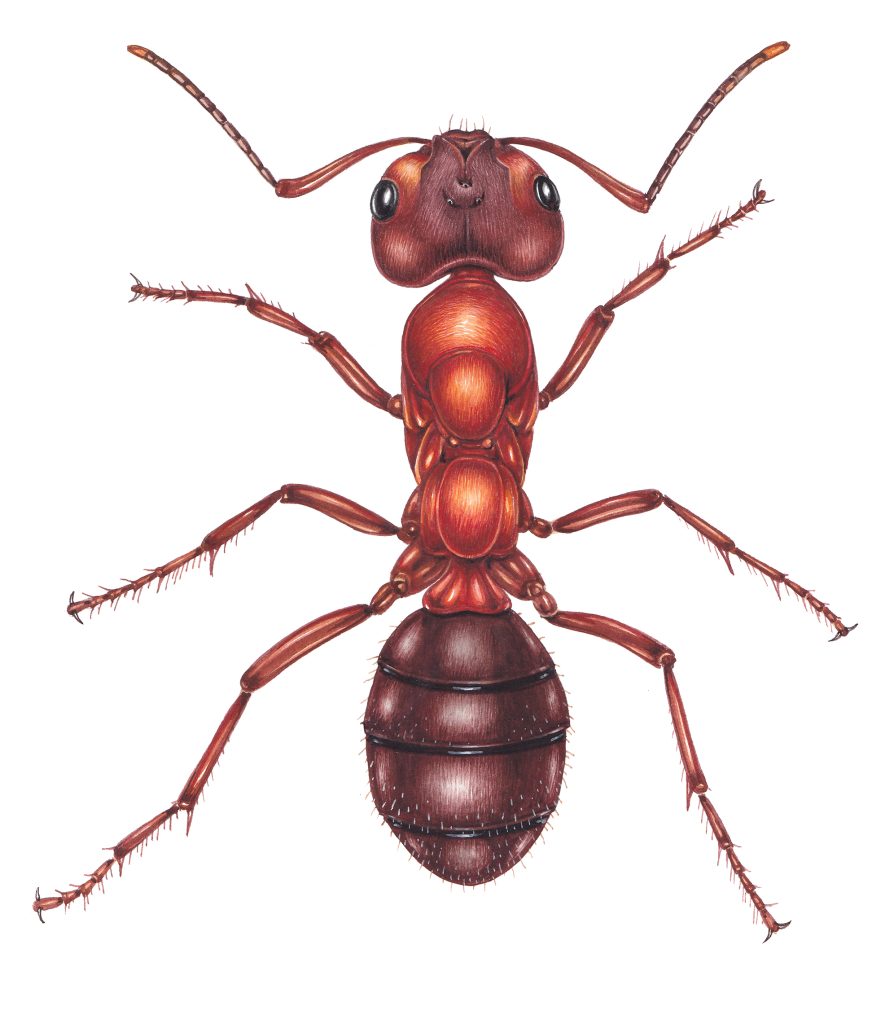
Slave making or Blood red wood ant Formica sanguinea
Wood ants species details
Initially, we thought the side views should be done in pen and ink. However, it was decided colour would work better. The most important aspect of these illustrations was the hairiness. Hairs had to be in the right place. They had to be the correct length. And on areas where they did not grow, I had to ensure the ant was suitably bereft.
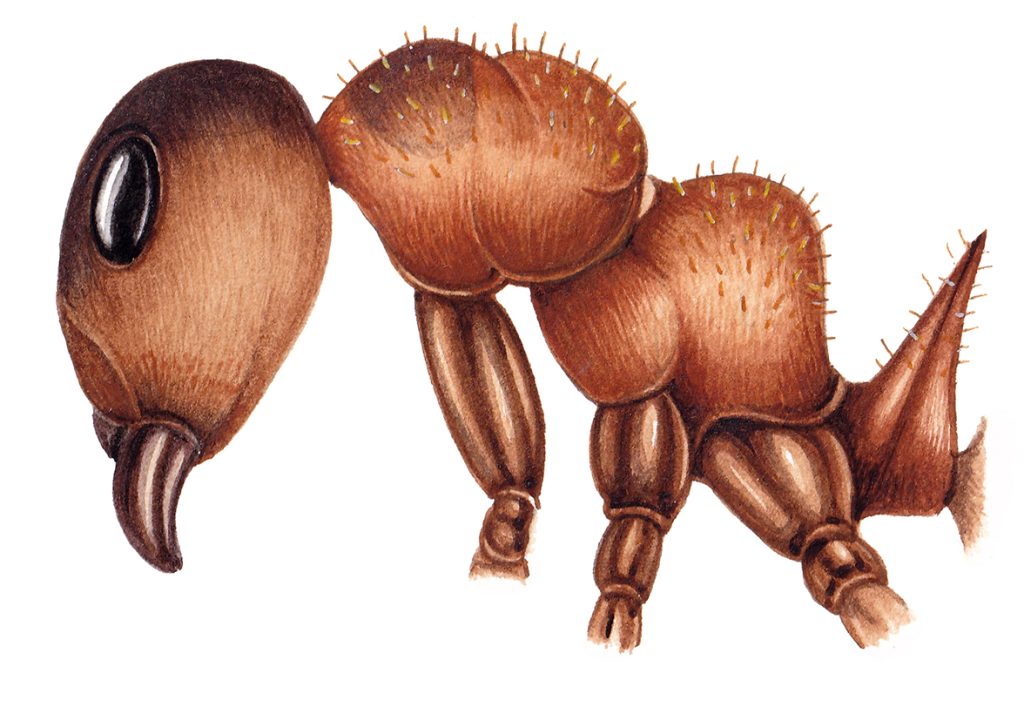
Thorax and hairs detail of Southern red wood ant Formica fusca
The trickiest part of this was getting the angle of the ant right. She had to be entirely side on. Figuring out exactly what was going on at the end of the thorax and around the gaster was a real challenge. Hairs on the ant body were added with white or pale yellow gouache.
Pen line drawings of the ants’ faces was a challenge too. In this case, it was the shape of the lip that mattered. And although I could sometimes see this on the photos from Mixie and Ant web, I needed Hayley to elucidate.
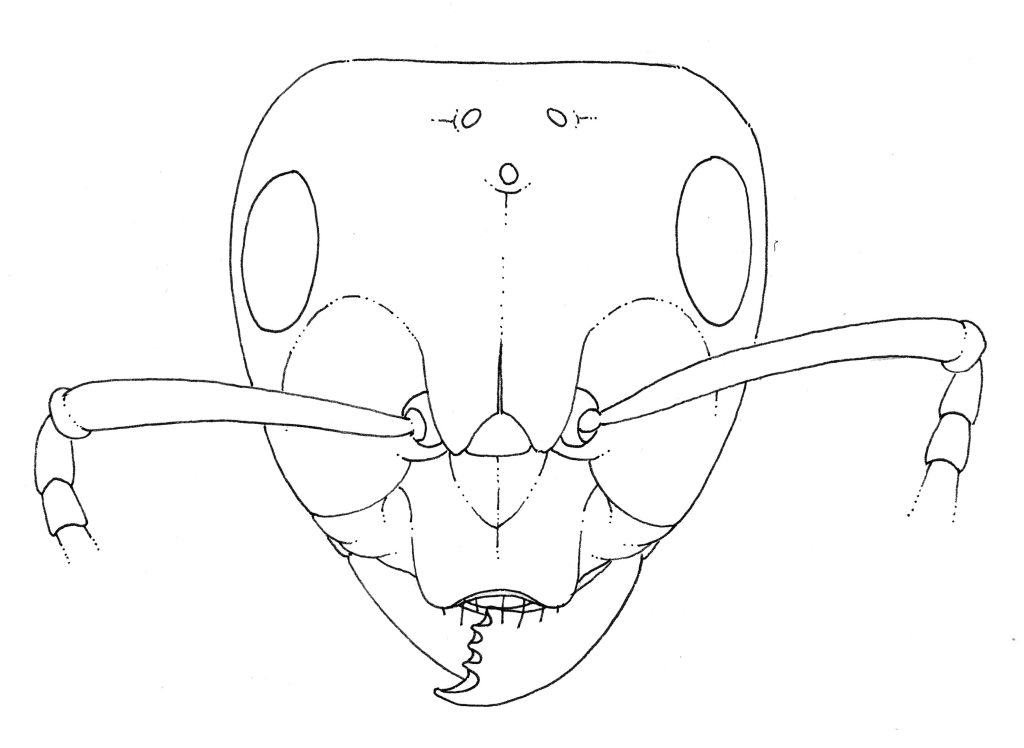
Face of the Blood red ant F. sanguinea showing a distinct notch in the upper lip or clypeus
Each ant ends up having an identification page to itself. This unites the pen drawing, side view, and ant portrait. it also is crammed with written detail.
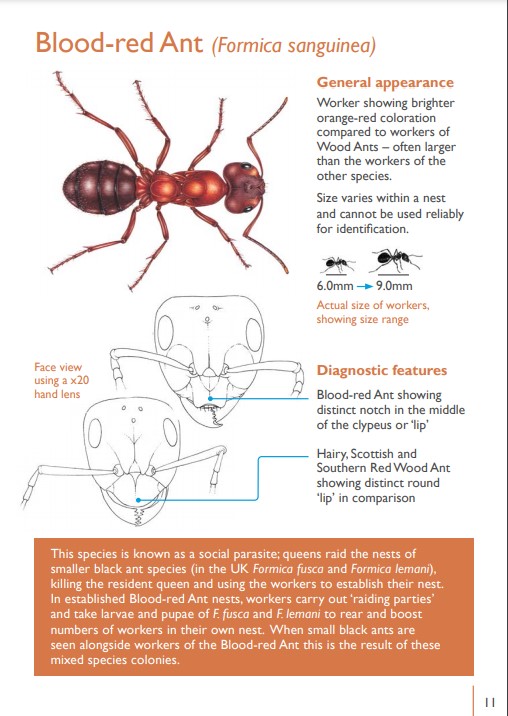
Blood-red ant F. sanguinea from the Wood Ants guide
Wood ants life cycle
The life cycle was really fun. I learned a lot from it, including that the male genitals of one species were bright yellow. Snazzy.
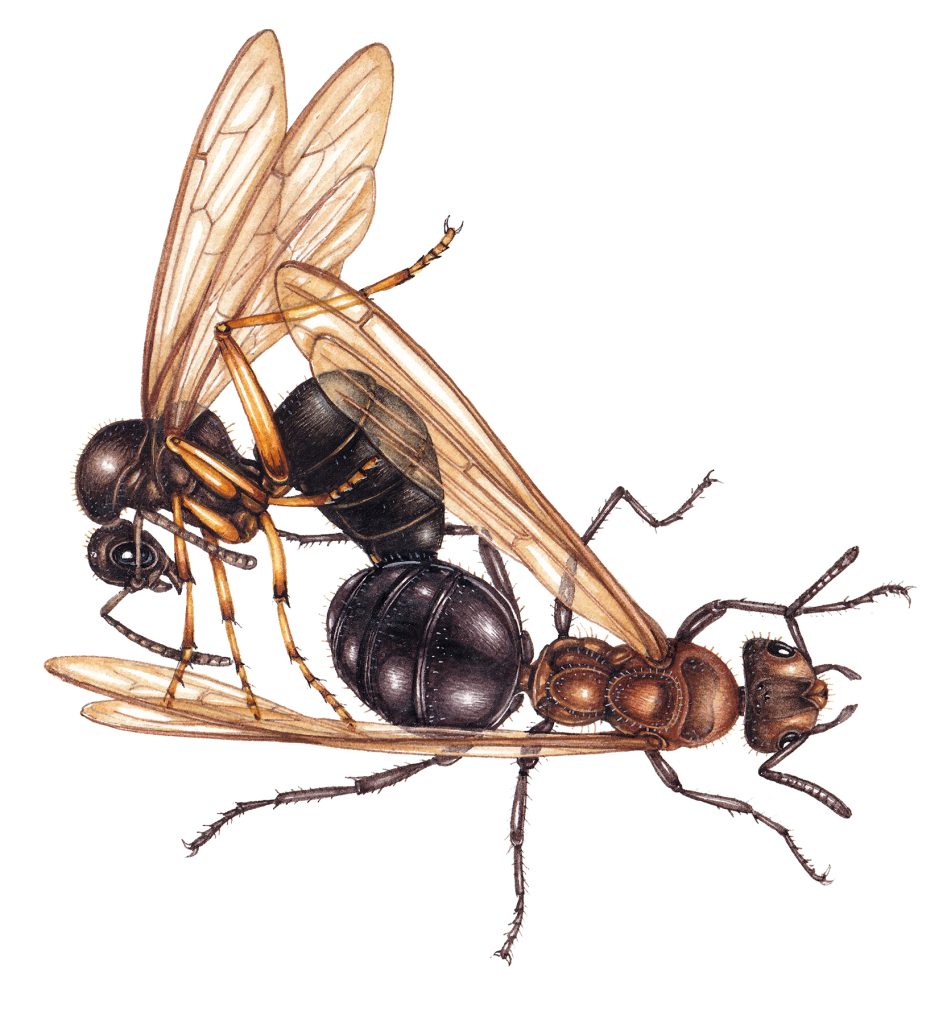
Mating and nuptial flight Formica rufa Southern Red wood ant queen and male
Building the illustrations of ants interacting was hard. It involved figuring out what they looked like as they fed one another, mated, or tended their queen. Using this, I needed to combine species specific “actors” to fill these roles. And then to tweak their legs and bodies and antennae to make it look natural.
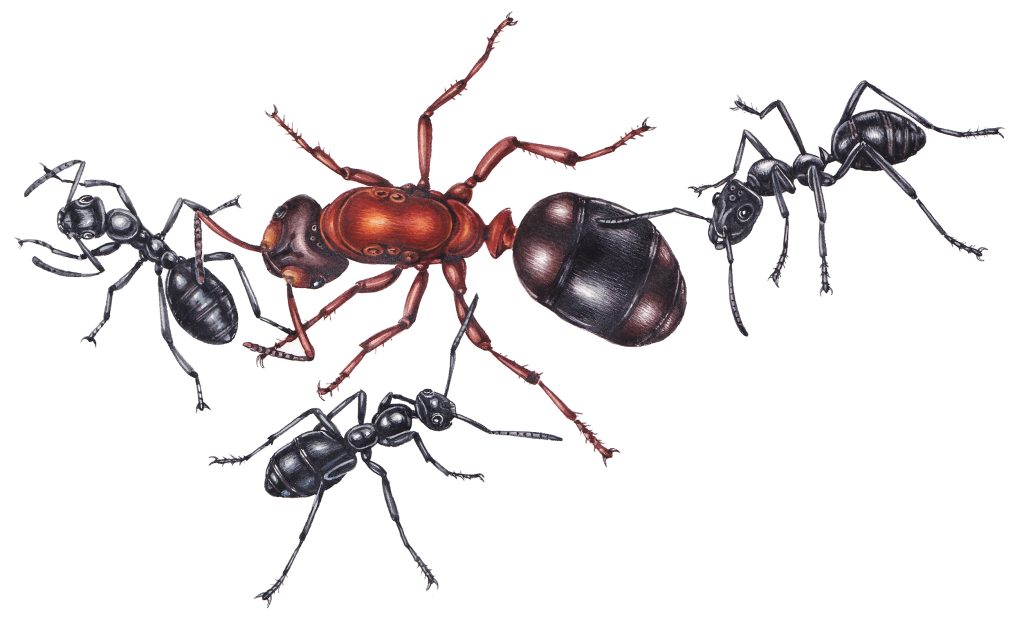
Social parasitism Queen of Slave maker Formica sanguinea and workers of Dusky ant Formica fusca
One of the most time consuming parts of the life cycle was the ant hills! Small and textured, capturing that straw and wood chip effect took a lot longer than I’d expected. And then you needed to add anchoring grass around it. And a budded, smaller ant nest nearby.

Ant nest with smaller “budded” ant nest
Seeing how well all the illustrations of the life cycle worked together was such a treat. The designers on this project have certainly worked magic. They’ve clarified some pretty complicated imagery, and made it feel interesting and accessible.

Wood ant life cycle from the guide.
Cover of the guide
Hayley and I struggled with how to approach the cover of the wood ants guide. We wanted some landscape, but also a close up of the ants. What should the ants be doing? How should we unite the ants with the distant misty view of the Cairngorms national park? We sent a great many sketches and roughs to and fro before settling on a final approach. Using the motif of a magnifying glass was key.
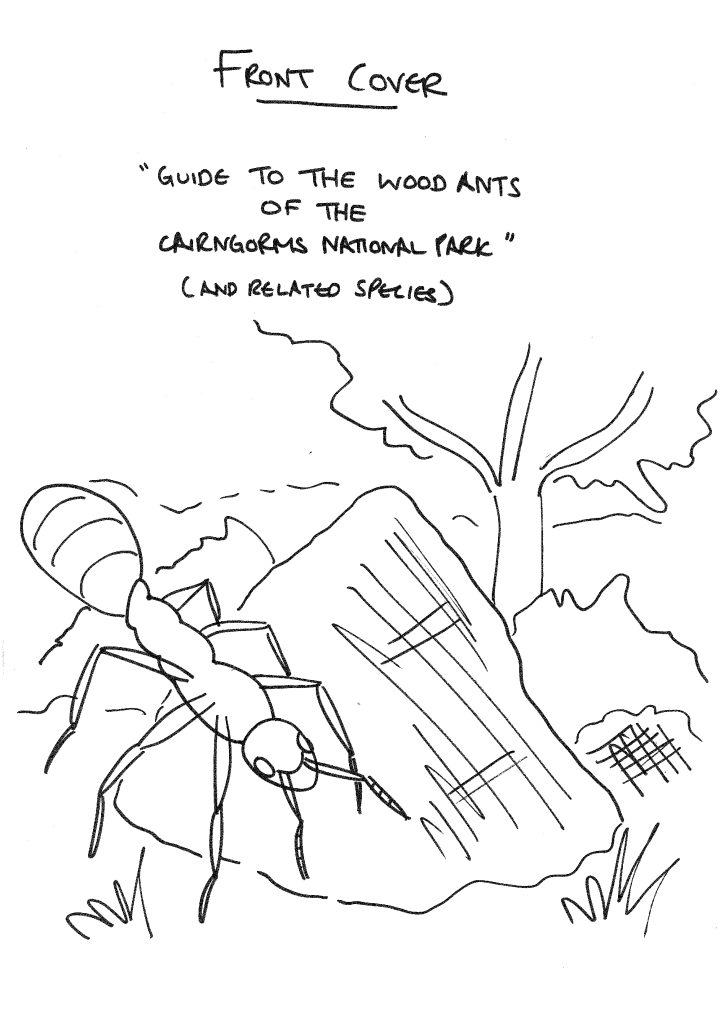
Hayley’s initial sketch of the cover concept

My early rough for the cover
The cover
We managed to get the detail we wanted with the magnified wood ants. They are practising trophallaxis, where social insects feed one another. We had some detail of the ant nest. Another ant nest a little further away was included, showing how they look in the landscape. The iconic Scot’s pine trees got to appear. And we also got to feature the heathery and distinctive landscape of the Cairngorms.
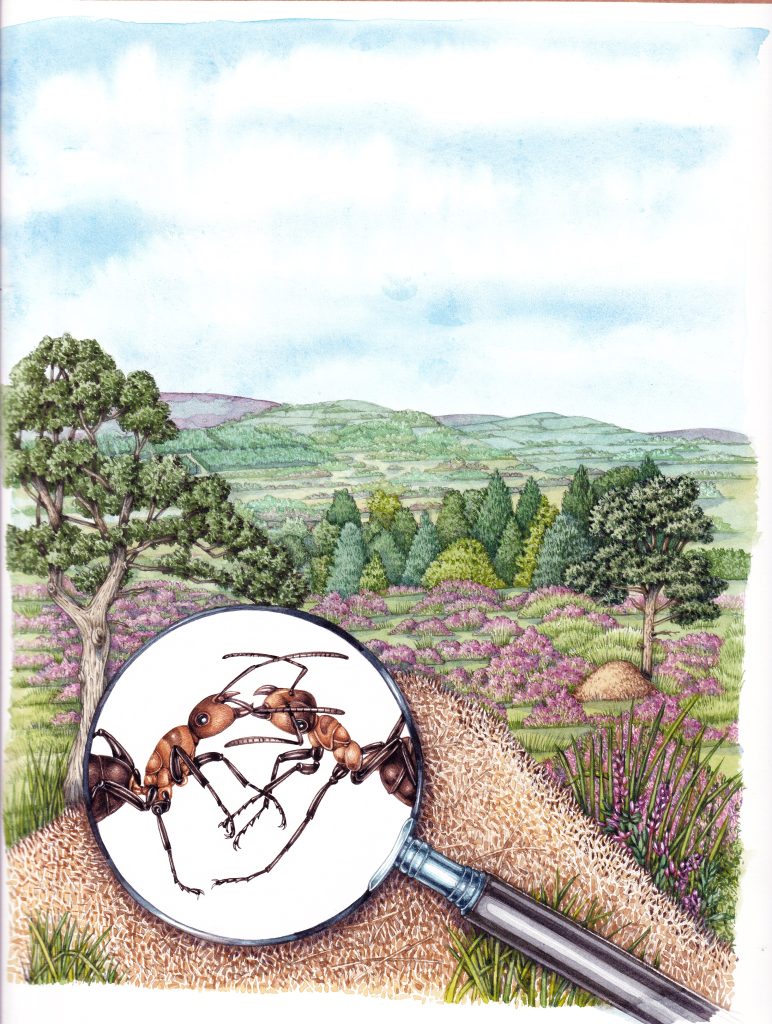
I struggled with the criss-crossing of antennae and legs. Once I’d untangled them, it was important to try and make it clear which ant possessed with legs. I think this comes across ok.
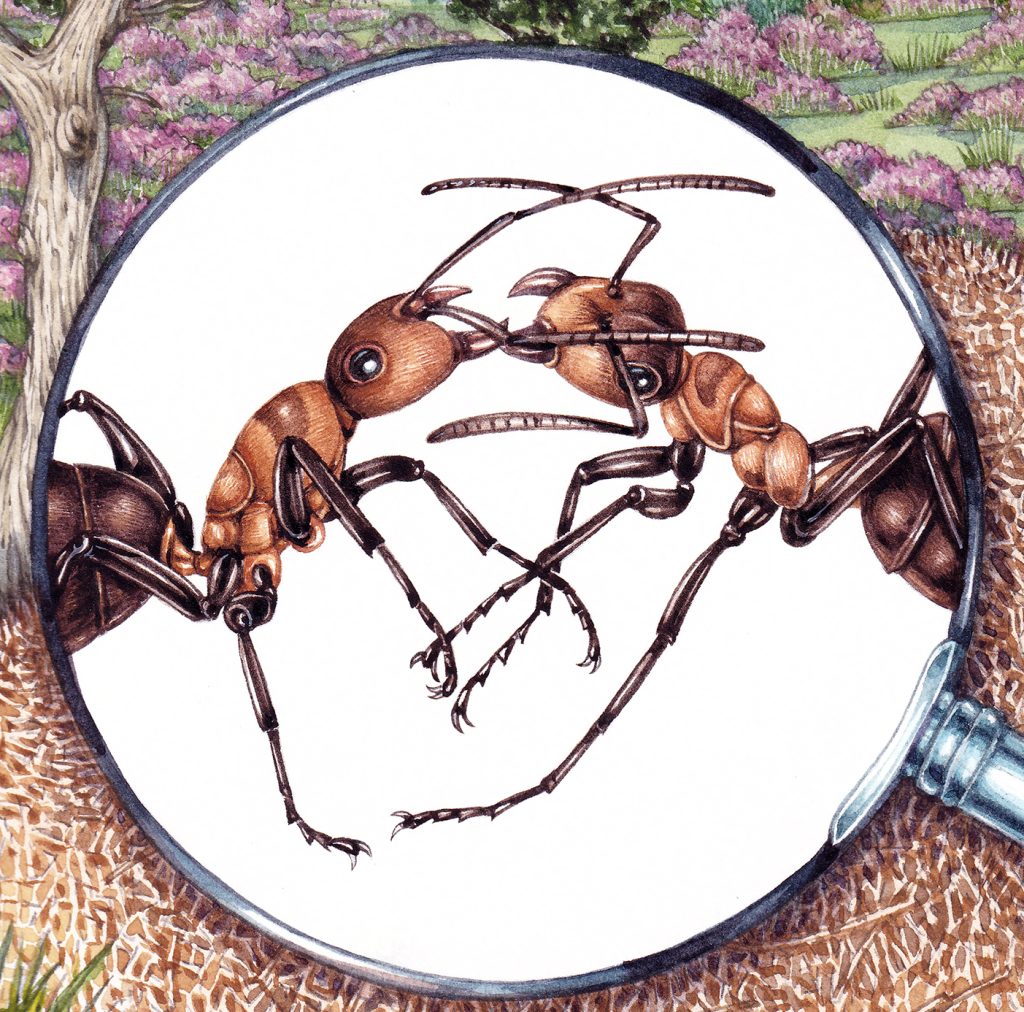
Another challenge was the texture of the ant hill. Having practised this on the life cycle, it was a little swifter. But I spent a many hours painting sticks and straw, and wishing fervently that I could move onto the ants. Another challenge was representing the metal and the edge of the magnifier. Painting circles free-hand is something I’ve never excelled at, so it was a challenge. but I think we got away with it. I enjoyed doing the metal. Sometimes illustrating a subject you rarely draw is fun, as it proved in this case.
Yet again, the designers have done a lovely job with the cover. They flipped the background, whilst keeping the ants in the same position. It alters and improves the composition of the illustration. I feel the cover draws people in, and although it’s a pretty technical subject, it makes the guide feel accessible to all. This is clever work on the part of the designers.

Cover of the Guide to the Wood Ants of the UK and related species
Conclusion
This was a really technically challenging project. I was over the moon that I was able to do it, and that the client and I are both pleased with the end result. Working to the edge of one’s ability is stimulating; you have to learn and you feel alive. I thoroughly enjoyed the challenge, and am really proud to be associated with such an excellent project.
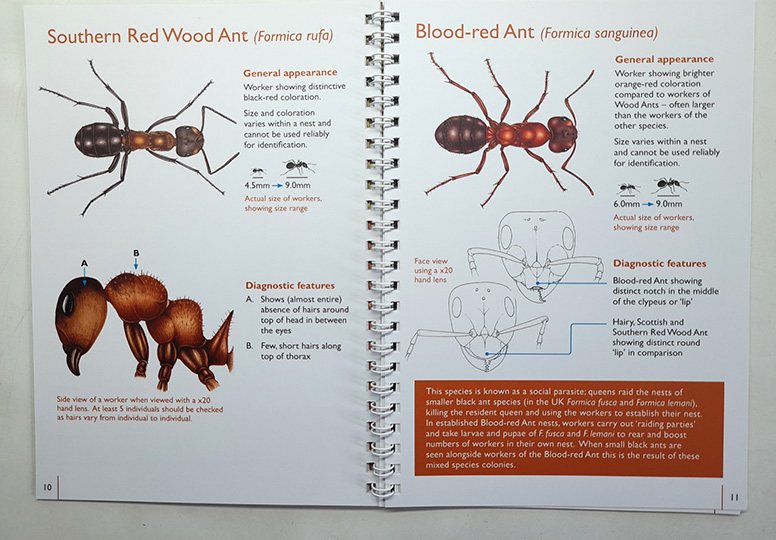
Double page spread from the guide: Southern Red Wood ant Formica rufa and Blood-red ant Formica snaguinea
To download a free PDF of the Wood ants guide, please visit: https://lnkd.in/d_qUdgU
The guide’s production was made possible with funding from Clif Bar & Company through their ‘National Parks Protectors’ initiative.
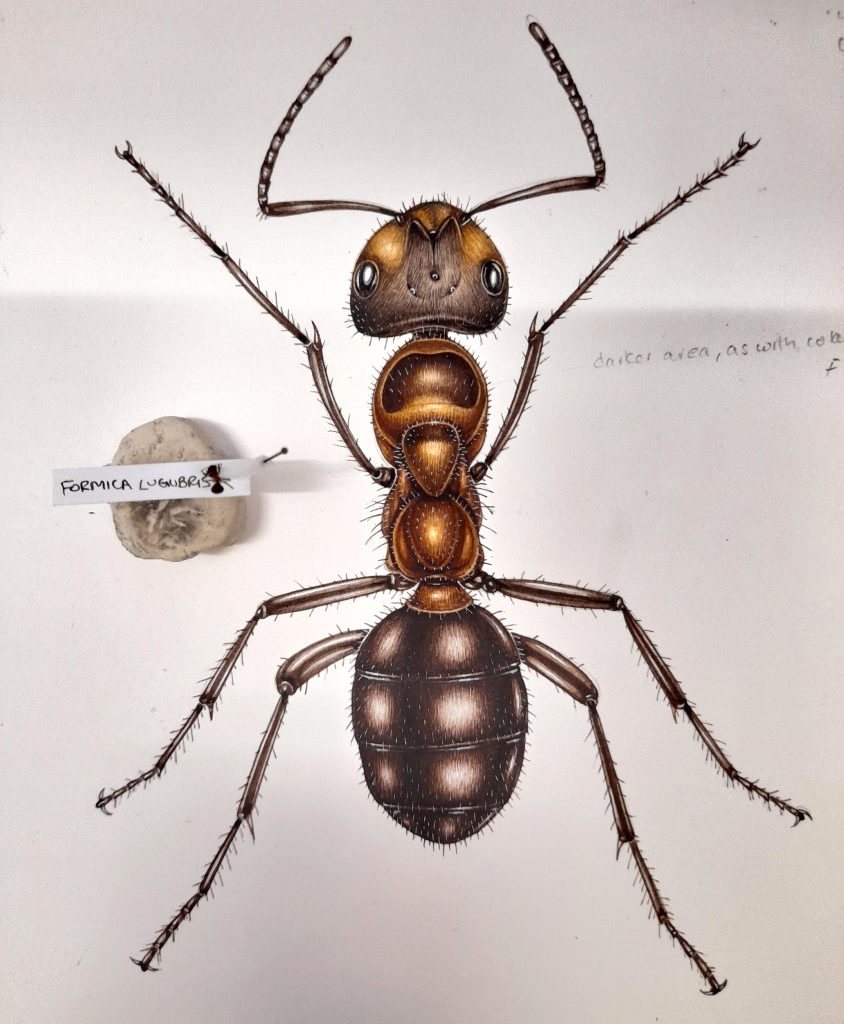
Hairy wood ant Formica lugubris illustration, alongside specimen
Below is a short piece of film showing me illustrating the Narrow headed wood ant, F. exsecta.


As a wood ant enthusiast I was really excited to find your blog, and to read about the challenges of producing the ant illustrations. The guide is stunning, and the illustrations are really superb, so congratulations on producing such a wonderful and useful series of illustrations – though the Cairngorms Park Authority have produced it, it is relevant no matter which part of the UK you are in. There is nothing else like it available. Thank you!
Hearing such a glowing review from someone who knows their wood ants in high praise indeed. Thank you so so much. Yes, Hayley decided to make it UK wide, which I think is a great decision. So glad you like it! And thanks for such positive comments! x
Fantastic!!! I will look at ants with a new appreciation. Incredible art work. So glad I found Lizzie Harper’s blogs. Enjoy them over and over.
Beth – Thankyou so much. Im really pleased you like the ant illustrations, and thanks for the positive comments about my blogs! x Lizzie